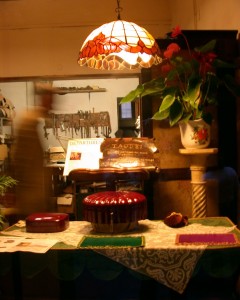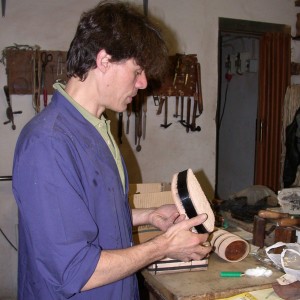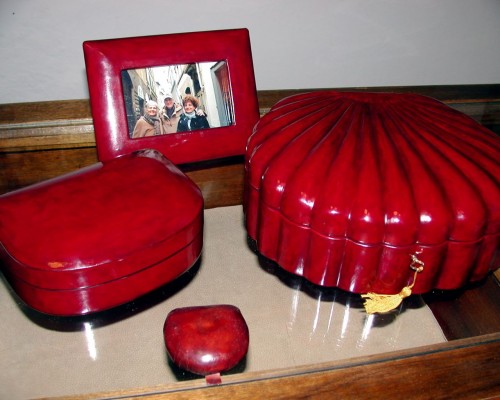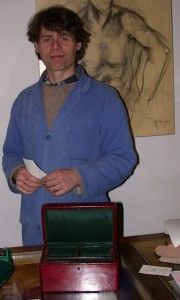Simone Taddei’s workshop/store, directly across the alley from Dante’s Church in Florence, should be visited when you have plenty of time. Not only are there elegant burnished leather boxes, picture frames, desk sets and other leather gift items to be examined, admired and purchased, but Simone is an enthusiastic interesting man, who loves to talk not only about his work, but also about his worldview. Simone is that rare character, a Renaissance man, descendant from generations of Florentines. He is a philosopher, an observer of history and politics, a family man, but above all, he is an artisan. He is the third in a line of Master Craftsmen, specializing in fine leather work.

History of the Taddei 1907-2008
At the turn of the last century, Giovanni Taddei, Simone’s great-grandfather, was a shoemaker. His son, Otello, wasn’t interested in making shoes. He wanted to make fine leather boxes and eventually apprenticed himself to an leather artisan (cuoietto artistico) in the neighborhood. His own workshop thrived and he taught his son, the gifted Giampaolo, Simone’s father, the high standards of the true master craftsmen. Often their jewelry boxes and desk sets, destined for the homes of the wealthy, were decorated with gold-leaf Florentine designs by other artists, known as dorati. By 1984, when Otello died, he and Giampaolo were well known in Florence and abroad as leather artisans of the highest order.
In 1976, Otello and Giampaolo became internationally known when they opened their first storefront studio on Piazza Pitti in front of the Pitti Palace. Orders came from the Paul Stuart Store in New York and Aspery in London. Simone, though still in school, started assisting in the workshop.

Simone and his father moved to the present location on Via Santa Magherita in 1993. Simone, now 47, says that it takes at least fifteen years to learn the skills necessary to be a master craftsman in leather, but that it was only after his father’s death in 1997 that he fully understood the precision and artistry demanded by the work. “When my father was here, he was always available to fix the flaws and assure that each piece was perfect. It was only when I was alone that I was responsible for keeping my own standards of workmanship at the highest level possible. It was very difficult.”
How To Make A Box 101
Simone’s boxes are completely made of leather. (His large jewelry boxes, requiring lock and key, and his picture frames have a wood core.) On average there are thirty-two steps and twenty days of work in each small and medium-sized box. The large and baroque-style boxes require forty steps and fifty days because of the extra layers of leather and the complexity of the design.
Each box starts with a wooden form on which dampened rawhide is bound and allowed to dry. Where the edges meet, Simone must shave the leather thin so that no joint is visible. The top and bottom of the form is covered with separate pieces of raw hide, completing the inner core of the box. Once the thick leather is completely dry, a thin supple layer of beige calfskin is attached with a natural paste and the edges are again shaved with a knife so that no seam shows.

The box, once dry, is dyed with a lanolin dye and burnished with a hot smooth steel hand tool applied with great pressure not once, but twice, over the entire box to bring a shine to the leather and enrich the color. The side is cut to either allow a natural leather hunge (three-sided cut) or to allow the top to come free and to remove the wooden form. The edges are finished and the final polish is done.
Endangered Species?
Simone Taddei is one of the few leather master craftsmen left in Florence, a city that used to be known for its fine leather artisans. He says this is for two reasons:
First, in November 1966, when the great flood ravaged Florence, most of the leather workshops were destroyed. (Otello and Giampaolo had just the year before moved their workshop to the northeastern periphery of the city where the flood waters didn’t reach.) After the flood, most of the leather craftsmen took the government recovery funds and started other easier and more profitable ventures.

Second, in the past ten or twenty years, the master craftsmen (not only working in leather, but also in marble, iron, inlaid stone, etc.) of the previous generation have not encouraged, or been able to encourage, the next generation to undergo the grueling fifteen year apprenticeship that leads to an admittedly uncertain economic future. Instead, the new generation is urged to work in banking, retail sales or try some other line of white-collar work.
Simone’s sixteen-year-old daughter and his five-year-old son are unlikely to follow the footsteps of their father, grandfather, and great-grandfather.
Simone will tell you that he is feeling alone in the ever-changing Florence that is turning into a facsimile of it’s former self, abandoning its artistic heritage.
Taddei
Via Santa Margherita, 11
Mon. – Sat. 8am-7pm
Closed Sun. & August
